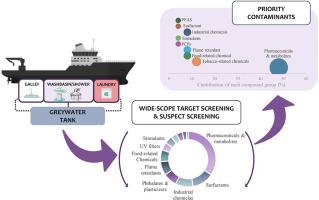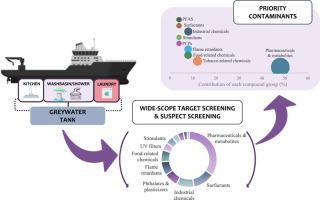利用LC-HRMS综合目标和可疑筛选方法识别船舶排放的灰水中新出现的污染物。
IF 7.3
2区 环境科学与生态学
Q1 ENVIRONMENTAL SCIENCES
引用次数: 0
摘要
海上交通的增加导致大量的污水排放到海洋环境中。来自水槽、淋浴间、厨房和洗衣设施的灰水含有多种化学污染物,受船上活动、船舶大小和管理实践的影响。由于缺乏对灰水管理的全面规定,加上对其化学成分的研究有限,因此需要对这些废物流进行特征描述。这项研究是第一个使用先进的液相色谱和高分辨率质谱(LC-HRMS)策略(包括大范围目标和可疑筛选)对船舶灰水样品进行全面表征的研究之一。目标分析检测到86种化合物,如药物、兴奋剂、烟草和食品相关产品、个人护理产品、紫外线过滤器、表面活性剂、全氟烷基化合物、增塑剂和阻燃剂,其中许多在常规监测计划中很少测量。此外,通过可疑筛选初步鉴定了另外11个化合物。一个新的评分系统进一步突出了25种对海洋生态系统构成生态风险的优先化合物,包括他他多、右旋孤儿、西酞普兰或厄贝沙坦等药物。本研究强调了通过污水排放大量引入μ L-1水平的化学物质,强调了迫切需要改进管理措施以减轻对海洋生态系统的生态风险。本文章由计算机程序翻译,如有差异,请以英文原文为准。


Identification of emerging contaminants in greywater emitted from ships by a comprehensive LC-HRMS target and suspect screening approach
The increase in maritime traffic has led to substantial greywater discharges into the marine environment. Greywater, originating from sinks, showers, kitchen, and laundry facilities, contains a wide array of chemical contaminants influenced by on-board activities, ship size, and management practices. The lack of comprehensive regulations for greywater management, along with limited research on its chemical composition, highlights the need to characterize these waste streams. This study is one of the first to provide a comprehensive characterization of greywater samples from ships using advanced liquid chromatography coupled to high-resolution-mass-spectrometry (LC-HRMS) strategies, including wide-scope target and suspect screening. The target analysis detected 86 compounds, such as pharmaceuticals, stimulants, tobacco and food-related products, personal care products, UV filters, surfactants, perfluoroalkyl compounds, plasticizers, and flame retardants, many of which are rarely measured in routine monitoring programs. Furthermore, 11 additional compounds were tentatively identified through suspect screening. A novel scoring system further highlighted 25 priority compounds posing ecological risks to marine ecosystems, including pharmaceuticals such as tapentadol, dextrorphan, citalopram, or irbesartan. This study emphasizes the significant introduction of chemicals at μg L−1 levels through greywater discharges, underscoring the urgent need for improved management practices to mitigate ecological risks to the marine ecosystem.
求助全文
通过发布文献求助,成功后即可免费获取论文全文。
去求助
来源期刊

Environmental Pollution
环境科学-环境科学
CiteScore
16.00
自引率
6.70%
发文量
2082
审稿时长
2.9 months
期刊介绍:
Environmental Pollution is an international peer-reviewed journal that publishes high-quality research papers and review articles covering all aspects of environmental pollution and its impacts on ecosystems and human health.
Subject areas include, but are not limited to:
• Sources and occurrences of pollutants that are clearly defined and measured in environmental compartments, food and food-related items, and human bodies;
• Interlinks between contaminant exposure and biological, ecological, and human health effects, including those of climate change;
• Contaminants of emerging concerns (including but not limited to antibiotic resistant microorganisms or genes, microplastics/nanoplastics, electronic wastes, light, and noise) and/or their biological, ecological, or human health effects;
• Laboratory and field studies on the remediation/mitigation of environmental pollution via new techniques and with clear links to biological, ecological, or human health effects;
• Modeling of pollution processes, patterns, or trends that is of clear environmental and/or human health interest;
• New techniques that measure and examine environmental occurrences, transport, behavior, and effects of pollutants within the environment or the laboratory, provided that they can be clearly used to address problems within regional or global environmental compartments.
 求助内容:
求助内容: 应助结果提醒方式:
应助结果提醒方式:


